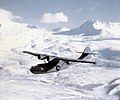

Aircraft repair ship is a naval auxiliary ship designed to provide maintenance support to aircraft. Aircraft repair ships provide similar services to seaplane tenders, that also cared for the crew. Aircraft repair ships had their own stores of spare parts, like a depot ship. Aircraft repair ships had repair personnel and equipment to repair failures or battle damage on aircraft. Aircraft repair ships also did regular aircraft maintenance. [1] [2]

















